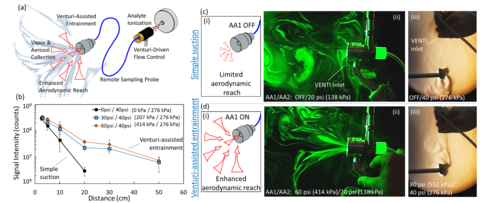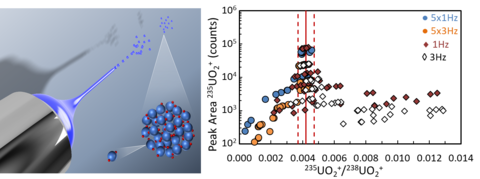Summary
Ambient and atmospheric pressure mass spectrometry platforms provide sample collection, transport, and ionization for vapor, aerosol, and liquid samples. Electro-, acoustic-, and pneumatic-actuation can be incorporated for droplet generation with electrospray, chemical, and photo ionization avenues.
Description
Surface and Trace Chemical Analysis Group employs a range of commercial pneumatically-assisted electrospray ionization (ESI), atmospheric pressure chemical ionization (APCI), and atmospheric pressure photoionization (APPI) sources for traditional mass spectrometric chemical analysis, identification, and quantification. In addition, a number of research avenues target the development of ion sources based on acoustic-actuation for the nebulization and ionization of discrete microliter injections, as well as novel vapor and aerosol collection, transport and ionization platforms. Below are a few examples of research conducted in these areas.
The collection and detection of vapors and aerosols in real-time plays an important role for a range of defense and environmental sectors. More specifically, the evolution of volatile peroxide-based homemade explosives (HMEs) has reinforced the need for vapor detection platforms to complement current trace detection platforms. The need for real-time and semi-remote sampling from large cargo containers has led to the development of the Venturi-assisted entrainment and ionization (VENTI) platform. VENTI efficiently entrains, collects, and transports vapor and aerosol species across multi-meter distances for mass spectrometric detection by integrating the Venturi and Coanda effects. Venturi-assisted entrainment enhanced the aerodynamic reach (distance across which vapors can be aerodynamically entrained into the detection system) over simple suction by 3-fold.

As mass analyzers evolve, characterization of these technologies and development of sound measurement science must also advance. For example, recent work characterized the capabilities of an ultra-high-resolution hybrid triple quadrupole time-of-flight mass spectrometer to analyze inorganic isotope ratios from discrete liquid injections by electrospray ionization. Important factors were identified for these temporally discrete samples, including mass spectral sampling rate, collision induced dissociation potentials, and mass resolution.

In addition to trace detection, isotopic signature analysis of inorganics plays an important role for explosive device detection and environmental monitoring. At the foundation of atmospheric pressure mass spectrometry lies to need for efficient gas-phase introduction and ionization of analytes. STCAG has research in the use of acoustic-actuation for the discrete nebulization of microliter sample solution aliquots coupled with in-source collision induced dissociation (CID) for the enhanced inorganic detection. Acoustic-actuation platforms include both surface acoustic wave nebulization (SAWN) and ultrasonic nebulization (USN) by bulk wave focusing within acoustic horn arrays. Both platforms enable the analysis of complex matrices and particulate suspensions by eliminating clogging issues traditionally seen with capillary-based electrospray ionization.


